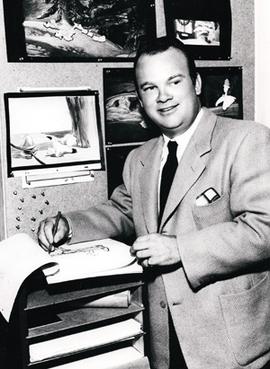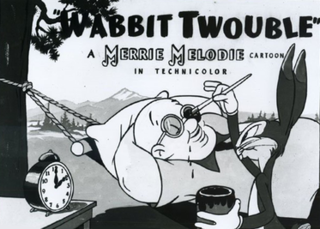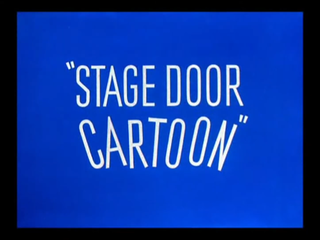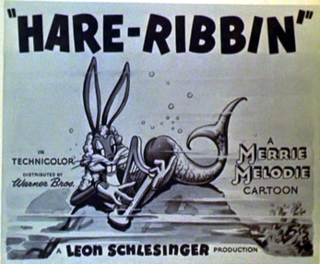
Frederick Bean "Tex" Avery was an American animator, cartoonist, director, and voice actor. He was known for directing and producing animated cartoons during the golden age of American animation. His most significant work was for the Warner Bros. and Metro-Goldwyn-Mayer studios, where he was crucial in the creation and evolution of famous animated characters such as Bugs Bunny, Daffy Duck, Porky Pig, Elmer Fudd, Droopy, Screwy Squirrel, The Wolf, Red Hot Riding Hood, and George and Junior.

A Wild Hare is a 1940 American animated comedy short film directed by Tex Avery, produced by Leon Schlesinger, and distributed by Warner Bros. as part of the Merrie Melodies series. The film was released on July 27, 1940, and features Elmer Fudd and Bugs Bunny, the latter making what is considered his first official appearance.

The Heckling Hare is a Merrie Melodies cartoon, released on July 5, 1941, and featuring Bugs Bunny and a dopey dog named Willoughby. The cartoon was directed by Tex Avery, written by Michael Maltese, animated by soon-to-be director Robert McKimson, and with musical direction by Carl W. Stalling. In a style that was becoming typical of the Bugs character, he easily outwitted and tormented his antagonist through the short, his only concern being what to do next to the dog.

Wabbit Twouble is a Merrie Melodies cartoon starring Bugs Bunny, produced by Leon Schlesinger Productions and released on December 20, 1941, by Warner Bros. Pictures.

Hare-um Scare-um is a 1939 Warner Bros. Merrie Melodies cartoon directed by Ben Hardaway and Cal Dalton. The short was released on August 12, 1939, and is the third short to feature the rabbit that would evolve into Bugs Bunny.

I Love to Singa is a 1936 Warner Bros. Merrie Melodies animated cartoon directed by Tex Avery. The short was released on July 18, 1936.
Egghead Rides Again is a 1937 Warner Bros. Merrie Melodies cartoon directed by Tex Avery. It was first released to theaters on July 17, 1937. The cartoon marks the first appearance of Egghead, a character who eventually appear in three more cartoons, "Daffy Duck and Egghead", "A-Lad-In Bagdad" (1938) and "Count Me Out" (1938), both cartoons released in 1938, according to David Gerstein and Michael Barrier.

Daffy Duck & Egghead is a 1938 Warner Bros. Merrie Melodies cartoon produced in 1937 and directed by Tex Avery. The cartoon was released on January 1, 1938, and stars Daffy Duck and Egghead.

Little Red Walking Hood is a 1937 Merrie Melodies cartoon supervised by Fred Avery. The short was released on November 6, 1937, and features the first appearance of an early character who later became Elmer Fudd.

Stage Door Cartoon is a 1944 Merrie Melodies cartoon directed by Friz Freleng. The short was released on December 30, 1944, and features Bugs Bunny and Elmer Fudd.

Hare Ribbin' is a 1944 animated short film in the Merrie Melodies series, directed by Robert Clampett and featuring Bugs Bunny. The plot features Bugs' conflict with a red-haired hound dog, whom the rabbit sets out to evade and make a fool of using one-liners, reverse psychology, disguises and other tricks. It was released in theaters by Warner Bros. on June 24, 1944. The title is a pun on "hair ribbon".
Of Fox and Hounds is a 1940 Warner Bros. Merrie Melodies directed by Tex Avery. The short was released on December 7, 1940, and introduces Willoughby the Dog. Avery performed the voice of Willoughby, and Mel Blanc voiced George the Fox and the bear's yells. The short is an attempt to duplicate the success of the 1940 Bugs Bunny short A Wild Hare by giving another anthropomorphic animal the same unflappable demeanor. The names of Tex Avery, Dave Monohan, Carl W. Stalling, and possibly Charles McKimson intentionally draft numbers in the credits.
Dangerous Dan McFoo is a 1939 Warner Bros. Merrie Melodies cartoon directed by Tex Avery. The short was released on July 15, 1939.
A Feud There Was is a 1938 Warner Bros. Merrie Melodies cartoon directed by Tex Avery. The short was released on September 24, 1938, and features the fourth appearance of an early version of Elmer Fudd.

Elmer J. Fudd is an animated cartoon character in the Warner Bros. Looney Tunes/Merrie Melodies series and the archenemy of Bugs Bunny. His aim is to hunt Bugs, but he usually ends up seriously injuring himself and other antagonizing characters. He speaks in an unusual way, replacing his Rs and Ls with Ws, so he often refers to Bugs Bunny as a "scwewy" or "wascawwy (rascally) wabbit". Elmer's signature catchphrase is, "Shhh. Be vewy vewy quiet, I'm hunting wabbits", as well as his trademark laughter.

Cinderella Meets Fella is a 1938 Warner Bros. Merrie Melodies directed by Tex Avery and written by Tedd Pierce, based on the fairy tale of Cinderella. The short was released on July 23, 1938, and features the third appearance of an early version of Elmer Fudd.
Count Me Out is a 1938 Warner Bros. Merrie Melodies cartoon directed by Ben Hardaway and Cal Dalton. The short was released on December 17, 1938, and features Egghead.

The Penguin Parade is a 1938 Warner Bros. Merrie Melodies directed by Tex Avery. The short was released on April 23, 1938.












